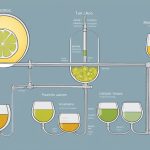Yeast Nutrient: Enhancing the Flavor and Performance of Your Fermentation
As a passionate homebrewer, I have always been fascinated by the intricacies of the brewing process. One crucial element that often goes unnoticed but plays a significant role in the success of fermentation is yeast nutrient. In this article, I will take you on a deep dive into yeast nutrient – what it is, why it matters, and how to use it effectively to take your brews to the next level.
Understanding Yeast Nutrient
Yeast nutrient, also known as yeast energizer, is a blend of essential minerals and vitamins that provide yeast with the necessary nutrients to thrive during fermentation. While yeast can ferment without nutrient supplementation, adding yeast nutrient to your brew can significantly improve yeast health, fermentation speed, and overall flavor profile.
Yeast nutrient typically contains a combination of compounds, such as nitrogen, vitamins, minerals, and trace elements. These elements are vital for yeast growth, reproduction, and metabolism. By providing an optimal nutrient environment, you can ensure that your yeast cells stay healthy and active throughout the fermentation process.
The Benefits of Using Yeast Nutrient
Using yeast nutrient offers a multitude of benefits, including:
- Improved Fermentation: Yeast nutrient promotes a healthier and more vigorous fermentation, allowing the yeast to efficiently convert sugars into alcohol and carbon dioxide. This results in a cleaner and more complete fermentation process.
- Faster Fermentation: The addition of yeast nutrient can expedite fermentation by providing the necessary nutrients for yeast to multiply and work efficiently. This can save you valuable time, especially when brewing beers with high gravity or complex recipes.
- Enhanced Flavor: Yeast nutrient helps to minimize off-flavors and ester production during fermentation, leading to flavors that are more balanced and true to style. This is particularly important for delicate beer styles or wines where subtle flavors should shine.
How to Use Yeast Nutrient
Now that we understand the importance of yeast nutrient, let’s discuss how to use it effectively:
- Read the Instructions: Different yeast nutrients may have specific instructions and recommended dosages. Always refer to the product label for guidance.
- Add at the Right Time: The best time to add yeast nutrient is typically during the yeast rehydration phase or at the beginning of fermentation. This ensures that the yeast cells have access to the necessary nutrients from the start.
- Measure Correctly: Use a scale or measuring spoons to accurately measure the recommended amount of yeast nutrient. Overdosing can lead to off-flavors, while underdosing may not provide the desired benefits.
- Consider Fermentation Type: Different fermentations may require different amounts of yeast nutrient. For example, mead or wine fermentations typically benefit from higher nutrient additions due to their higher nutrient demands compared to beer fermentations.
Remember, yeast nutrient is not a magic elixir that can fix all fermentation issues. It is crucial to maintain proper fermentation temperature, pitch an adequate yeast cell count, and ensure overall sanitary conditions to achieve the best results in your brews.
Conclusion
Adding yeast nutrient to your brewing or winemaking arsenal can be a game-changer. It provides yeast with the essential nutrients they need for a healthy and successful fermentation, resulting in improved flavor, faster fermentation, and a more enjoyable end product. So, next time you embark on a brewing journey, don’t forget to give your yeast a helping hand with some quality yeast nutrient – your taste buds will thank you!







